It’s been a half century since Paul Avrich’s definitive history of the Kronstadt mutiny first appeared — and a full century since the revolt itself. Others have written about how “Red Kronstadt”, whose sailors had been hailed as the “pride and joy” of the Bolshevik Revolution by Trotsky himself, turned on the Communists and tried to trigger a nation-wide “third revolution”. But few have been professional historians.
Avrich’s book is strikingly balanced. He does not shy away from acknowledging that the Bolsheviks had little choice but to swiftly crush the rebellion if they intended to stay in power. Nor does he paint the rebels as angels; his references to their anti-Semitism make for painful reading. He does some serious myth-busting, not least the Bolshevik claims — demonstrably false — that White generals and France were behind the rebellion.
He demolishes Trotsky’s later claims that, in spite of being the commander of the Red Army and actually being on the scene when the rebellion was suppressed, he really played a very minor role and bears little responsibility for the events. Zinoviev comes off pretty badly as well, having ruthlessly suppressed not only the Kronstadt sailors but also rebellious workers in the city of Petrograd, which he ruled as a dictator. Both men would fall victim to Stalin’s purges, though Stalin himself played no role in the suppression of this mutiny.
In the end, Avrich paints Kronstadt as a tragedy, which it surely was, but also shows the sailors’ vision of a society of “free soviets” no longer dominated by the Communist Party as a missed opportunity.
